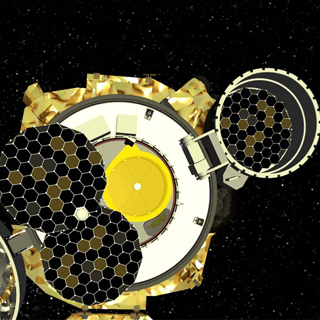Tom Friedmann (01112) was one of six researchers awarded NASA’s Exceptional Engineering Achievement Medal (EEAM) at a ceremony June 15 at the Jet Propulsion Laboratory in Pasadena, Calif. He received the award for the quality of the diamond-like carbon thin films he contributed to the Genesis science mission. The other five winners were all members of JPL.

The purpose of the Genesis mission was to collect the solar wind that is ejected from the outer portion of the sun, itself thought a kind of fossil of the original nebula that transformed into our solar system 4.5 billion years ago. The captured materials could test the validity of solar-formation models. The EEAM award acknowledges Tom’s contributions as critical for mission success.
“The films were selected due to their purity,”says Tom. “They made possible the sensitive determination of the composition of the solar wind that implanted itself in the samples during the mission.”
The Genesis collector arrays house the high-purity materials into which solar wind ions are implanted. The total surface area of the collector arrays is over 1 square meter (11 square feet). (NASA photo)
Because the solar wind is diffuse, the Genesis probe exposed the film samples on orbit for more than two years at the Earth-Sun Lagrangian point (the point where earth and sun’s gravity cancel) to obtain statistically significant implants. The satellite then folded up its collectors and returned to Earth for sample analysis.
“The reentry was supposed to be managed by deploying a parachute and gently catching the probe with a helicopter,” Tom told the Lab News. “Unfortunately, the parachute did not deploy due to the misorientation of an accelerometer that was supposed to be activated by the deceleration upon reentry.”
Because the sensor was installed backward, the satellite then crashed into the Arizona desert. Although this resulted in contamination of the samples, the Genesis team was able to recover and clean most of the samples and still accomplish much of its ongoing science mission, Tom says.
The Exceptional Engineering Achievement Medal, established in 1991, is awarded to both government and nongovernment individuals for unusually significant engineering contributions toward achieving NASA’s mission.
According to a NASA handout, “Accomplishments are far above others in quality, scope, and impact. Accomplishments are explicit, demonstrate results, and are perceived as outstanding or significant by peers and impacted target groups.”
For information regarding the Genesis mission see: http://Genesismission.jpl.nasa.gov/. For information regarding NASA awards see: http://nasapeople.nasa.gov/awards/nasamedals.htm.